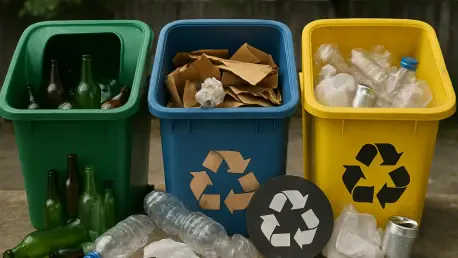What happens when a state drowning in waste decides to fight back with innovation and grit? California, grappling with overflowing landfills and looming environmental deadlines, has just witnessed a game-changing moment as Governor Gavin Newsom signed a trio of transformative bills—SB 279, AB 70, and AB 899—into law. Picture this: mountains of organic waste rotting in dumps, emitting methane at alarming rates, while local glass manufacturers struggle to compete with cheap imports. These new laws aren’t just paperwork; they’re a lifeline aimed at reshaping how Californians manage waste and recycle resources. This is a story of policy meeting urgency, a narrative that could redefine sustainability in the Golden State.
Why This Matters: California’s Waste Crisis
The importance of this legislative package cannot be overstated. California has set ambitious targets to divert 75% of organic waste from landfills by 2025 under previous mandates like SB 1383, yet the state is falling short, with methane emissions continuing to climb. Landfills are nearing capacity, composting facilities remain scarce, and local industries face economic threats from foreign competition. These bills tackle those challenges head-on, offering solutions that span agriculture, energy, and manufacturing. They represent a critical step toward meeting environmental goals while protecting jobs and communities, making this moment a turning point for every resident and business in the state.
Turning Trash into Treasure: The Power of SB 279
At the heart of this legislative push is SB 279, a bill designed to revolutionize composting across California. Farmers now have the green light to manage up to 500 cubic yards of compost on-site and distribute 5,000 cubic yards annually without burdensome regulations. Community and urban farms also benefit from raised limits, empowering local efforts to keep organic waste out of landfills. This isn’t just about numbers; it’s about giving growers an alternative to costly waste transport or banned burning practices, slashing both expenses and emissions.
Environmental advocates are buzzing with approval. A spokesperson from Californians Against Waste declared, “This law puts power back into the hands of communities to manage waste locally, cutting methane at the source.” The ripple effect could be massive—less waste in dumps means cleaner air and a stronger push toward state diversion goals. For rural areas especially, where off-site facilities are often hours away, this change is nothing short of a practical lifeline.
Fueling the Future: AB 70 and the Biogas Boom
Shifting focus to energy innovation, AB 70 introduces a bold approach by recognizing renewable natural gas (RNG) from organic waste as a creditable diversion method when injected into the grid. Unlike past rules that limited credits to on-site biogas use, this bill opens new doors for large-scale impact. It also clarifies the role of pyrolysis, a technology previously sidelined, setting the stage for future waste management strategies.
Bioenergy leaders see this as a turning point. An executive from a leading firm noted, “Grid-injected RNG can transform waste into renewable energy on an unprecedented scale.” With California lagging behind methane reduction targets, this legislation offers a pragmatic tool to bridge the gap. It’s a signal that technology and policy can align to tackle one of the state’s most pressing environmental issues, potentially powering homes and businesses with what was once just trash.
Saving Glass, Saving Jobs: AB 899’s Recycling Push
Then there’s AB 899, a lifeline for California’s glass industry, particularly wine bottle production. By boosting payments for recycled glass cullet from $50 to $150 per ton and extending the program to 2030, this law aims to make domestic recycling competitive against subsidized imports, especially from China. It’s a direct response to the economic strain felt by local manufacturers who struggle with higher operational costs.
The Glass Packaging Institute has thrown its full support behind the measure. A representative emphasized, “This increase is a game-changer for manufacturers fighting to stay afloat against cheap foreign glass.” Beyond economics, the environmental win is clear—more recycled glass means less waste and a smaller carbon footprint. This bill cleverly ties sustainability to job preservation, showing how green policies can bolster local economies.
Voices from the Ground: Stakeholders Weigh In
Across the spectrum, reactions to these laws highlight their real-world stakes. Farmers, long burdened by waste disposal challenges, view SB 279 as a breath of fresh air, with one Central Valley grower stating, “On-site composting saves us time and money while doing right by the environment.” Urban community leaders echo similar optimism, seeing expanded composting limits as a chance to engage neighborhoods in tangible green action.
Industry perspectives add depth to the conversation. Bioenergy advocates argue that AB 70’s biogas provisions could spark investment in grid infrastructure, while glass sector insiders stress that AB 899’s incentives are critical to maintaining a domestic supply chain. These diverse voices—from rural fields to urban centers and corporate boardrooms—paint a picture of broad support, united by a shared goal of balancing ecological responsibility with economic survival.
What’s Next: Making These Laws Work
Looking back, the signing of these bills by Governor Newsom marked a pivotal chapter in California’s sustainability journey. The path forward, however, demands action from all corners. Residents can play a role by supporting local composting initiatives and choosing products made with recycled materials, amplifying the impact of these policies. Farmers and businesses must seize the opportunities—whether through on-site composting under SB 279 or tapping into AB 70’s biogas credits—to turn waste into value.
State agencies face the task of ensuring smooth implementation, from providing guidance on new regulations to securing funding for infrastructure growth. Policymakers need to monitor progress, ready to adapt as challenges like global trade pressures or technological hurdles emerge. Above all, the success of these laws hinges on collaboration, proving that a greener California is not just a vision, but a shared responsibility built on innovative steps taken in that historic moment.









